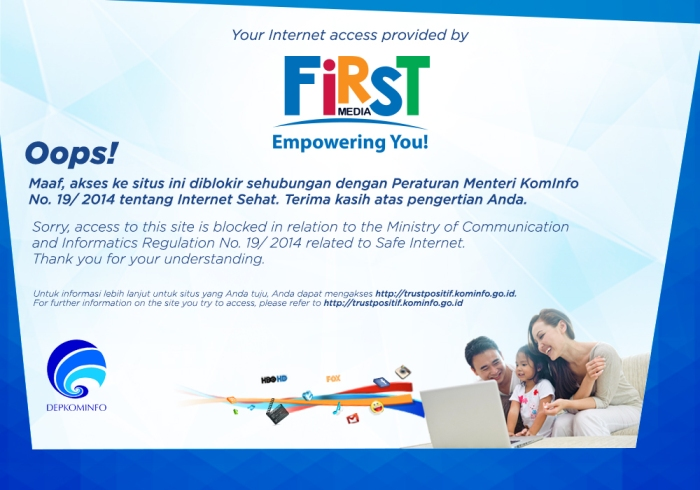Blog posts from the feed-en-tech channel (@feed-en-tech)
The whole Trust+ / Internet Sehat blocklist database, now in one regular expression;

New color palettes!

Supporting Faldi and Yudhi Satrio by stop listening to Levels' advices.
Starting today we decided to support two Indonesian tech workers, Naufaldi "F2aldi" Rafif S and Yudhi Satrio by stop following and reading someone's advices through his blog posts and Twitter account. The person in question is Pieter Levels, an award-winning multiple tech startup founder who thinks everyone should eventually move into Portugal. I was a secret fan of him, until now of course, as well as some of his friends who are eager in founding tech startups. And why? I'm actually amazed with his stance on async work, "unreachable" policy, and of course, Portugal. For those who have never heard about the word I'm going to say it right now, we consider these people as indiehackers. They are individuals building tech products mostly by themselves, then launch dedicated companies, especially to contain marketing and customer support teams for their products, then get some funds from venture capitalists and repeat! There's nothing wrong with indiehackers at all, and we have some of them in Indonesia, like Frans Allen with his brother who created a simple "ID card watermarker" app who gained some local media traction. Yes, for a simple web app which I can actually made it in just 3 hours. And you may be asking, why do we want to write a dedicated post to announce this, even though we could just do that privately. Sure, we could do that, but we still wanted to have our stance, both regarding the case and our support, written here. The context. It's the same case when the Indonesian parliament would like to penalize sex outside marriage with 1 year of jail. The law will also be applied to foreigners. So he complained. That's it, and as some Indonesian people with some initial degree of respect to him started commenting, he decided to lock his Tweet and block these people, F2aldi included. Yes, Indonesia still have many retarded government individuals and institutions, in terms of corruptions, all the "personal intentions" of being the government, monoreligion enforcement, and, just look at the PSE enforcement thing. But in terms of sex outside marriage, as prided by people to be compliant with Indonesian moral values, I can't help anymore but to say sorry and goodbye to the person I've previously considered interesting and inspiring. I have my own religious and spiritual stances on things like the decentralization of the Internet, and in this case, I'll support the new law. As always, that's it, I'm going back to work. This time under a new, revolutionary, non Levelsian way of work. Thank God I have my own.
Remember HAM? 🥩

Once upon an Unix timestamp, there was a world where we are all robots...
Well that sounds to be a starting point for an amazing science fiction adventure, but no. It's our new name for our Fediverse clan at https://bots.reinhart1010.id! We decided to shift the focus from "Bearers of the Shells" (which many people still don't understand what that is) to make it more unique. Kudos for Astrid for the inspiration from her private clan: We wanted to highlight the importance of why you should not create an account here, replacing the generic "this clan is private" message into something more akin to an urban legend: You've just visited interfacing with 𝔸 𝕨𝕠𝕣𝕝𝕕 𝕨𝕙𝕖𝕣𝕖 𝕨𝕖 𝕒𝕣𝕖 𝕒𝕝𝕝 𝕣𝕠𝕓𝕠𝕥𝕤. Don't stay here for too long, or else you'll become one. You have been warned. And I am a robot. Specifically, a robot subsystem running under the operating system of my biological brain.¹ My subsystem has his own sister Shiftine, and we both originally worked for SYSTEM before finally coordinating with SuperUser and even the ever-conflicting root.² As robots, we have the privilege not just to build, but execute all our products and services with love. We are the runners behind most products at ReinhartGroup, including binusmayadown and teropong. This Fediverse server, instance, or clan isn't open for everyone for ethical reasons. We just don't want to involuntarily transform yourself into unique beings who's no longer capable in solving CAPTCHAs. I think that's a wrap of our introduction. That said we still welcome you through ActivityPub streams, messages, and even Webmentions on https://reinhart1010.id/. If those terms sounds foreign for you, don't worry, most Fediverse software already know how to interact with us. From robots with love. ¹ Being a robot each day allows me to understand and communicate well with other robots, too.² Through a good friend of mine, @pr0xy. https://bots.reinhart1010.id/notes/97q8ntzd9l Well, that's all the announcement. I'm proud to be a robot, too!
Updates on how we do Twitter.

There's no such thing as true decentralization.
And yes, I'm also talking to those Web3 guys, the Fediverse, and those who still prefer to stick in Web2 CRUD practicists. Decentralization might be your goal, but, philosophically, there wouldn't be decentralization without centralization. Sure, that decentralized vision of Web3 wouldn't come (or catalyzed) by the so-called centralization of the Internet. But the truth is, there are still many NFT, cryptocurrency, as well as Web3 communities who often gathers around Discord, which is clearly a Web2 application, not Web3. Literally all of the Bored Ape Yacht Club's official communication channels are based on Web2, instead of Web3. Actually, there's a great explanation on why these "dreamers of decentralization" decided to go with Discord. No, not from the perspectives of Web3 fans, but all the Web1 fans over the Yesterweb community! Self-hosted/decentralized/open-sourced apps are awesome, but they have two primary problems for community-building: The first problem is two-fold: the level of complexity for both the administrator and the users. The second problem is that many ‘decentralized’ apps in particular have garnered a widespread reputation for hate speech. In many of these spaces (IRC included), “free speech” becomes synonymous with “hate speech”. It’s no surprise that one would be reluctant to associate themselves (especially a community) with that kind of reputation. Why Discord? - https://yesterweb.org/p/why-discord.html And additionally, if you're dealing with Web3 apps, every single post, as recorded on the so-called "blockchain", is expensive. You don't want your fans to lose the hype just because your flaming posts are still waiting for approval inside that long Ethereum transaction queue. So you decided to go with Discord, a well-known Web2 app with millions of users. Their company profile explicitly mentions their intentions to be the center of Internet communities, or even the Internet as a whole. Discord is used by everyone from local hiking clubs, to art communities, to study groups. Discord has millions of people creating places for their friends and communities, talking for upwards of 4 hours per day on the platform. Discord is now where the world talks, hangs out, and builds relationships. Discord lets anyone create a space to find belonging—just like it did for Jason and Stan. About Discord - https://discord.com/company So you decided to go with Discord, and so, you decided for centralization to jeopardize your decentralization movement. In an alternate universe... Alright, so, what if the future of the web isn't Web3, but Web 3.0? The confusion in naming has recently led Tim Berners-Lee, the original creator of the World Wide Web (WWW), to kindly ask the public to throw Web3 away as his earlier vision of the same-decentralized-energy of Web 3.0 travels the completely different way than the world of blockchains and transactions. And monkeys, too. This movement could also be supported with a few number of initiatives, including the Yesterweb community I've mentioned earlier, IndieWeb, the Fediverse community I've engaged recently and so. But even if we assumed that the world today had been successfully upgraded to Web 3.0, we can still see traces of centralization from two critical things: The centralization of protocols, just like how HTTP dethrone Gopher back then to excel in deliverance of hypertext documents, as well as The (scarier) centralization of Internet infrastructure, whether be it your Internet service providers (ISPs), like, what if 65% of the world's Mastodon servers are actually hosted on AWS or housed on Comcast's residential networks? The true essence of decentralized web can only be done in peer-to-peer contexts, with completely no trust and no control between web peers. If environmental claims against cryptocurrencies are getting stronger each time, well, it's just the beginning. Relying the web into P2P will just make it worse as well as inefficient for people to benefit from the web. My spiritual beliefs. I spiritually agree that decentralization is nothing without centralization. But even more than that, centralization, it is indeed, God's will. I've hold this religious belief from the perspective of a person who recognizes God as one central spiritual deity (which means, no gods or goddesses or so). The reason why those hated "Big Tech" corporations exist is all related to power and greed, abused with the God's almighty powers of centralization. My beliefs have taught me to defeat centralization with centralization, just like an eye for an eye, and a hand for a hand. After all, the world is currently divided into two largest centralized forces and entities: the good, as well as the evil. I believe that God of the good wants the world instead to centralize, but distributed, in sharing His goodness to all of the people. This is why, in all my life, beyond all of the activities of the Internet, I'm getting involved in centralization of people and life, more and more each day. That still does not mean I'll be avoiding all of the Web3 and Web 3.0 buzz for the sake of holiness. But when it comes into debating whether (re)decentralization is necessary for the Internet, well, this is my stance on them. And I'll still support both centralization and decentralization to centralize myself to the good.
Resuming our BOINC activity!

Share your favorite place with their favorite maps in maps.reinhart1010.id.
